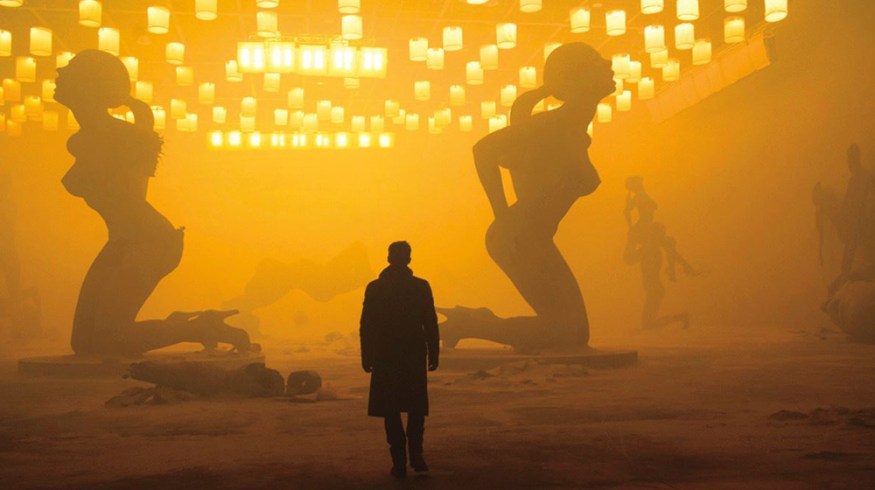
How Roger Deakins Shot and Lit Blade Runner 2049
Take a look at the lighting cinematographer Roger Deakins designed to capture the visually stunning footage in Blade Runner 2049.
Top image via ARRI.
In this article, we are going to take a quick look back at Roger Deakins’s previous work with ring lights — and how he built a massive lighting rig for Blade Runner 2049. Then we will take a look at how Deakins shot the film, as well as a few new tutorials you can check out to create your own looks inspired by Blade Runner 2049.
Roger Deakins Ring Lights
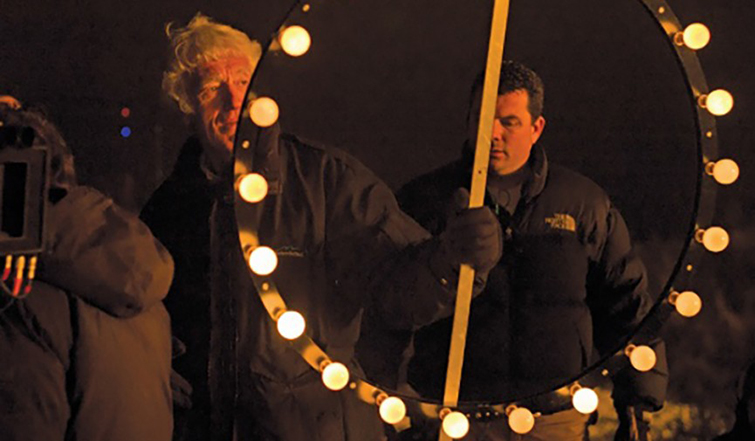
In a previous article, 5 DIY Tutorials and Gear Hacks for Filmmakers, we covered building a Roger Deakins-style ring light. Ring lights have become one of Deakins’s signature tools, and on each film, the rings get bigger and bigger. Before talking about the lighting of Blade Runner 2049, let’s look back at Deakins talking about ring lights:
They are really simple things though: some wooden rings of varying diameter with sockets for household bulbs every 5″, some straight wooden strips with similarly spaced sockets, steel hoops with evenly spaced 200/300 watt halogen bulbs, sockets grouped like the fingers of your hand which also take 200 watt halogen bulbs, a household socket with the socket for a 200 watt halogen bulb behind it etc etc.
When we last talked about these ring lights, Deakins had shared the following on the massive ring light that his grips and gaffers built for A Serious Man…
This was a light I had made which consists of 5 concentric hexagonal aluminum strips holding 200 odd 75 watt household bulbs. The largest hexagon is 15′ across and the smallest 3’6″ across. It was controlled by a dimmer system and a skirt of ultrabounce acts as a cut as well as an interior reflector.
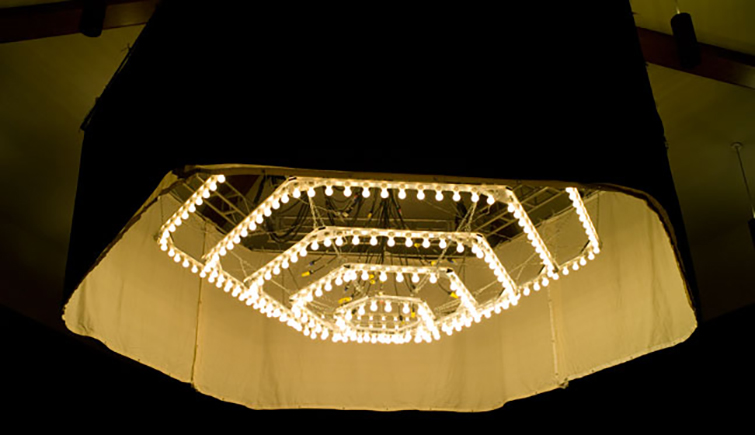
Image A Serious Man… via Roger Deakins.
This was a light I had made for a Synagogue location in A Serious Man… We had a large number of shots to shoot in this particular location so my problem was to light the space in such a way as I wouldn’t take much time relighting for every angle. This rig was suspended from chain motors at an average of 20′ above the centre of the space. The total output would have been about 17Kw but as the lamp was dimmed down to about 40% it was not all that intense. I was only shooting at a base of 2.6 on 5218 with a little high speed work for which we raised the intensity of the light. We added some bounce from shot to shot, usually dropping muslin from the rig itself, but that was all the additional lighting we used.
Lighting Blade Runner 2049
When it came to the look of Blade Runner 2049, Denis Villeneuve and Roger Deakins spent quite a bit of time deciding the right atmosphere. In an interview with IndieWire, Deakins recalls the following:
It was about trying to find Wallace’s character and Denis and I spent a lot of time talking about the look of the interior… We looked at a lot of references of the way architects use light in modern buildings, and especially the way light falls on some of these big concrete structures.
There was one particular cathedral that’s a big concrete block with two skylights that lets light in a most interesting way. We thought about an artificial world in which lighting moves like sunlight. I went with that and little patterns. Denis wanted the main space to be a big platform in the middle of a pond (based on an architectural design we’d seen). And the idea was to play with water with caustic patterns to evoke different emotions.
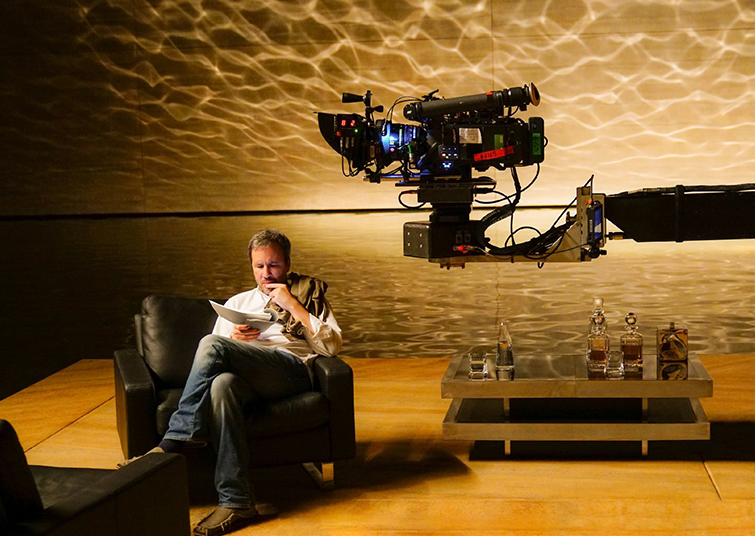
Image Denis Villeneuve via Columbia Pictures.
In an interview with ARRI, gaffer Bill O’Leary talked about the naturalistic look of Blade Runner 2049. His team of 20 crew members assembled massive ring lights on multiple locations:
I had nine weeks of prep time for a shooting schedule of around 90 days. We often had up to six stages working at Origo Studios and three at Korda Studios, in various stages of rigging, shooting and de-rigging. In total we had a lighting crew of around 20. They were without doubt the best crew I’ve worked with, apart from my regular New York crew, who I’ve been with for decades. Having such a top-notch rigging crew and top-notch programmers meant that dimming control was not at all difficult, despite the huge lighting package.
Here is a look at one of the lighting packages: 256 ARRI 300-watt Fresnels connected to two rings to simulate the sun and the sun’s shadows.
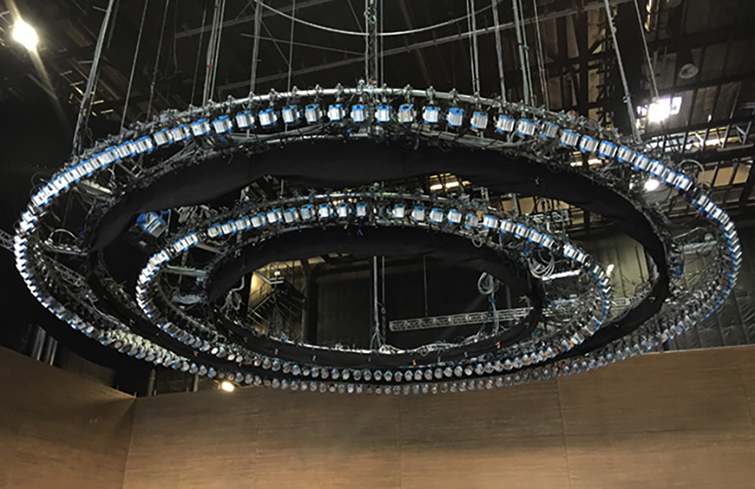
Image Blade Runner 2049 Ring Light via ARRI.
This light ring was used in the office of Niander Wallace, played by Jared Leto. It lit the actors on the platform — designed to look like the sun shining through a skylight. O’Leary explained the setup:
We used 256 ARRI 300-watt Fresnels in two concentric circles. The doors were removed so that each lamphead was literally touching the next. When a slow chase was programmed, it appeared as a soft source of about eight lamps circling the subject. This required quite an elaborate dimmer installation.
Here is a look of the light in action on set.
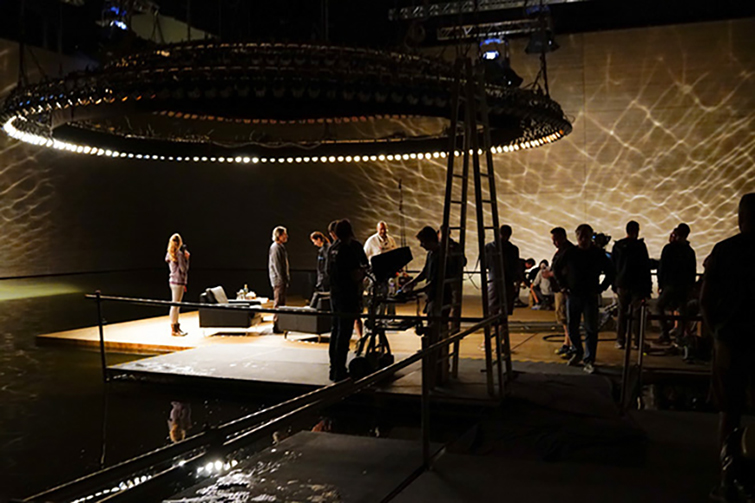
Roger Deakins elaborated on this setup over on his forum.
Similar in concept but the one I used for ‘A Serious Man’ utilized household bulbs to get a broad soft light effect, whereas here I used 300watt Fresnel lamps to focus the light in a specific area. The light still appeared soft because of the width of the number of lights burning at any one time. To begin the scene we had, maybe, 12 lamps on at any one time but the center of these twelve lamps would be the only ones at anything like full intensity. The outer lamps of the twelve would have been almost off. This effect ‘chased’ around the circle and the number of lamps burning at any one time grew as the scene progressed.
As for the beautiful water reflections on the surrounding walls, Deakins explained as follows:
The water was lit with 10K Fresnel lamps. There were two per side making eight in all. It was a very tricky rig because it had to be quite high, so as to not be in shot, and the lamps had to have the right angle to reflect and spill across the wall as they do. I was originally expecting that I could do this effect without lighting the water so much. The bottom of the pool had been painted black so, in my naiveté, I thought it would stay quite dark. Consequently I asked my gaffer, Billy O’Leary, to construct long barn door extenders so that the pattern of light on the water would be a pleasing symmetrical shape and the light from the two lamps would merge together.

In another thread, Deakins elaborated a bit more on the two scenes shot on this set:
I will eventually post the lighting diagrams for this and other sets. I always wanted to light the two scenes on that set quite differently. The first lighting design was something I had thought out well before the idea of the pool was finally locked in. This was based on the idea of sunlight coming through skylights in the roof and was similar in a way to the initial wide shot that introduces the Records Library. Of course, the addition of the element of water helped me create a second quite different look for that ‘interrogation’ scene. But the caustics were just a background to the actual character lighting, which was also something I had been thinking about for some time. It seemed a natural extension of the theme of moving light.
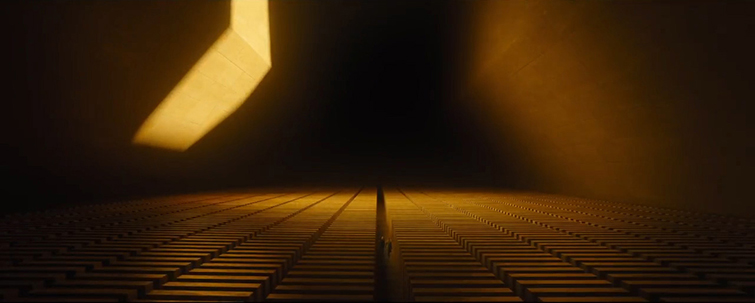
The library scene Deakins is referring to was entirely lit by ARRI SkyPanels. Bill O’Leary talks more about that setup:
This was a large set with a coffered ceiling containing milk glass panels. We had a construction box in each separate opening to act as a snoot and hung an ARRI S60-C in each box. There were 100 SkyPanels in total. This allowed us to achieve an effect of each row turning on as the characters crossed the set. I also found the SkyPanels easy to integrate into a more standard tungsten setup.
In the ARRI interview, O’Leary was asked how the interiors we kept so soft and warm with atmospheric colors:
Roger achieved most of the look in-camera. For the lighting, we used soft sources and lots of gels on the lampheads to create the different color atmospheres. We went through almost 1,400 rolls of gel by the time we had finished shooting!
Shooting Blade Runner 2049
As for shooting the film, Deakins went with an all ARRI package with ALEXA XT Studio cameras with Master Prime lenses. The sets mentioned before, and many other major scenes, were shot on sound stages in Budapest.
As for the scale of the sets, Ryan Gosling recalled in an interview with Entertainment Weekly that “It’s really incredible… I was so overwhelmed by the scale of them and how specific and, although, beautiful they are.”
As for working with Deakins:
Roger is a master. If there’s a Mount Rushmore of DPs, he’d be right there in the middle. He goes about his work very modestly and quietly, but you learn so much from just looking. You realize that once you are in one of his shots, half your job is already done.
In this “making of” video from Vice, you’ll go on set to see Deakins and Villeneuve at work, with the cast and crew — and even get a glimpse at some of the set pieces and props.
Recreating Blade Runner 2049
If you are looking to recreate some of the looks of Blade Runner 2049 yourself, check out these tutorials.
First, Film Riot shows you how to create the look of the desert in Blade Runner 2049 in After Effects.
In this tutorial from RocketStock, you can learn to track your character’s eyes. You’ll learn how to create the original red replicant eyes from the first film as well as Niander Wallace’s white eyes from the sequel. It also includes free project files and assets, so be sure to download the free project on RocketStock.
A Little More Deakins
It should be no surprise that we love writing about Roger Deakins. Here are a few more pieces you may really enjoy.
- How to Frame a Medium Shot Like a Master Cinematographer
- 10 Tips from Master Cinematographer Roger Deakins
- Cinematography Tips from The Best In The Business
To mark ARRI’s 100th anniversary, the company put together a series of interviews with legendary DPs, cinematographers, lighting technicians, and more. Here is the interview they conducted with Roger Deakins on the art of cinematography.






